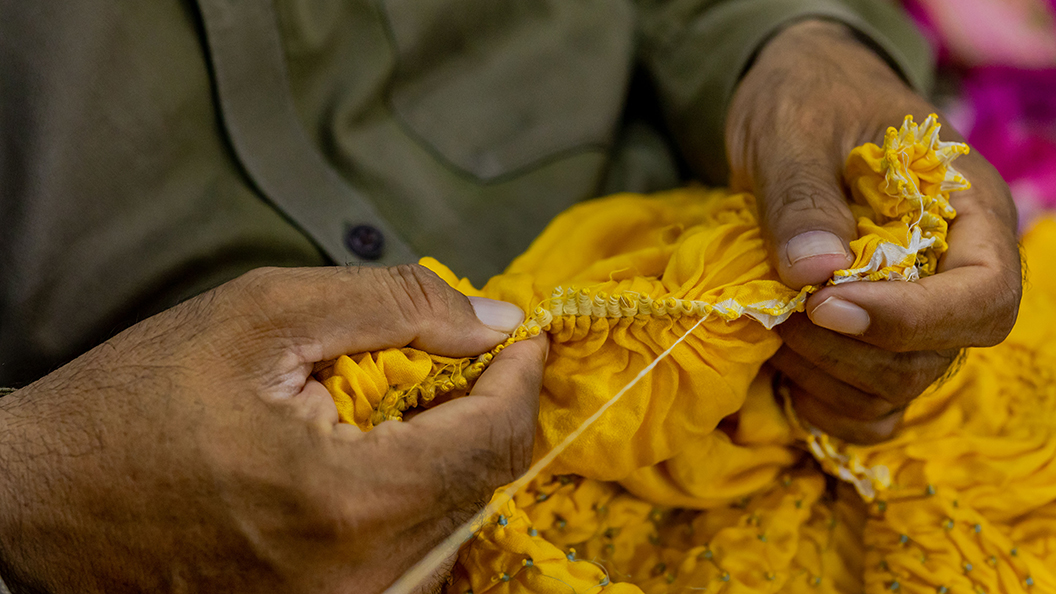THE CRAFT
Bandhani Tie & Dye

From the states of Gujarat and Rajasthan

Gujarat and Rajasthan
The origins of Bandhani technique are hard to trace. The earliest examples uncovered come from the time of the ancient Indus Valley civilization. Experts believe the craft has been in Kachchh for a few hundred years. It's practiced in Rajasthan and Gujarat by traditional dyers, the Khatris who were invited to Kachchh by Maharao Khenkarji. Traditionally, Jamnagar in Gujarat was famous for Bandhanis. However, with design innovation and the sturdy surge of the local Bandhani artisans, Kachchh is seen as the primary centre of Bandhani.

Heritage Value
A long and painstaking process, Bandhani involves tying and dyeing a pinch of a material at a time, following the design of the textile to create a pattern of tiny dots. The fabric is first washed, and then the cloth is then folded two to four times before being knotted and dipped in dye. The more the number of dots or knots, the more intricate, complex and expensive the piece. For patterns like the ambadal (a gateway-like structure), the arches are first drawn by hand with a pigment that wears off.
In Kachchh, the centres for Bandhani weaving include Bhuj, Mandvi, and Mundhra. Jaipur and Jodhpur in Rajasthan are also prominent weaving centres. It requires two extraordinary skills, not always found in the same artisan. One is tying the knots, and the other is precisely dyeing those knots per design. Some of the finest tying in Kachchh, especially on silk fabric, is done in the villages in Abdasa and Nakhatrana. Several communities here dress in vibrant Bandhani clothes, as part of their everyday and ceremonial attire. The base fabric of the Bandhani includes gajji silk, fine cotton, muslin, and wool. The gharchola, a specific Bandhani textile is worn by Gujarati brides for their weddings and is considered auspicious. In Rajasthan, the pregnant or childbearing women are gifted peele ki sari to celebrate. This sari traditionally has a yellow base and a broad red border with Bandhani patterns on it.
In Kachchh, the centres for Bandhani weaving include Bhuj, Mandvi, and Mundhra. Jaipur and Jodhpur in Rajasthan are also prominent weaving centres. It requires two extraordinary skills, not always found in the same artisan. One is tying the knots, and the other is precisely dyeing those knots per design. Some of the finest tying in Kachchh, especially on silk fabric, is done in the villages in Abdasa and Nakhatrana. Several communities here dress in vibrant Bandhani clothes, as part of their everyday and ceremonial attire. The base fabric of the Bandhani includes gajji silk, fine cotton, muslin, and wool. The gharchola, a specific Bandhani textile is worn by Gujarati brides for their weddings and is considered auspicious. In Rajasthan, the pregnant or childbearing women are gifted peele ki sari to celebrate. This sari traditionally has a yellow base and a broad red border with Bandhani patterns on it.

Memory Vault
Wool Bandhani, a unique textile is primarily made in Nakhatrana. People of this region showcase their communities with the colours of the dots on the wool. The Dhebaria and Kutchi Rabaris wear a black ludi (shawl-like garment) with red dots, while the Vaghadia Rabaris wear orange Bandhani dots on black. The special bridal ludi of the Rabaris is called the suhagadi neelakwali, it's a woollen Bandhini shawl with dots in orange and green.
Disclaimer:
Any information on this page is anecdotal and based on publicly
available details. If you're interested in learning more,
click here.